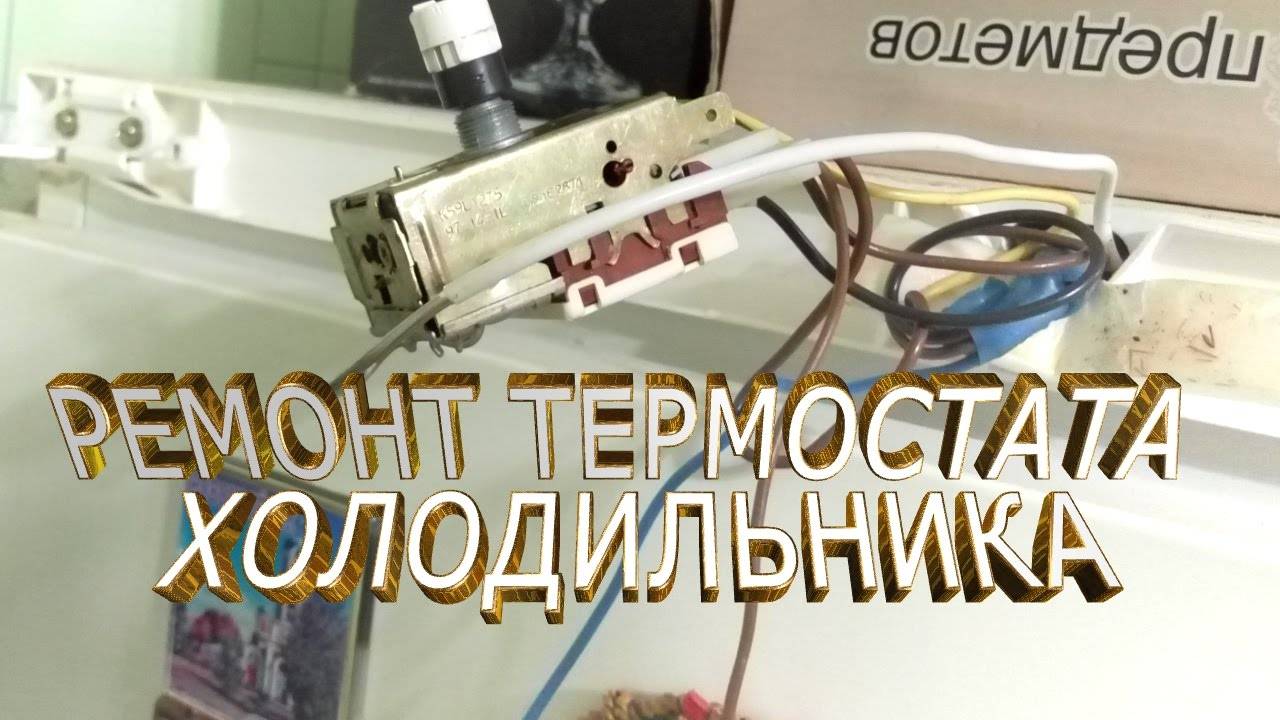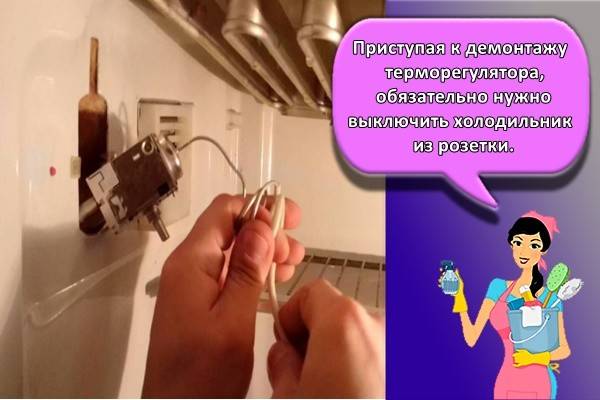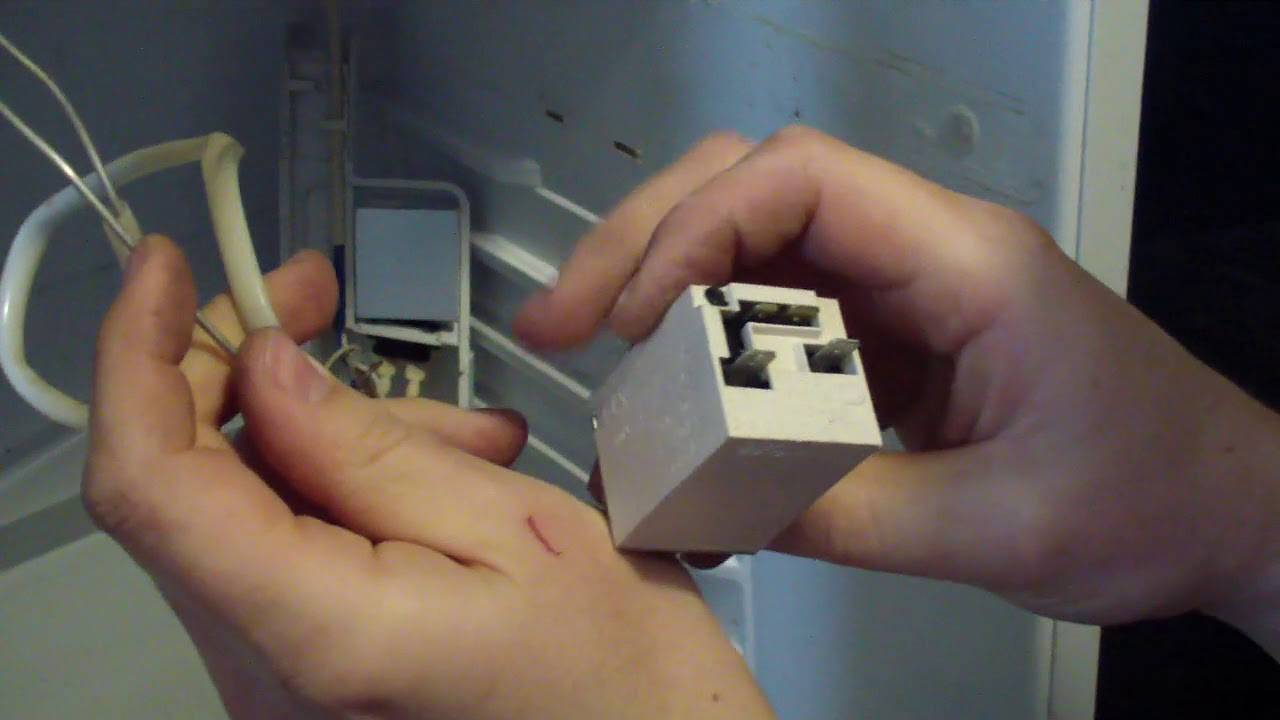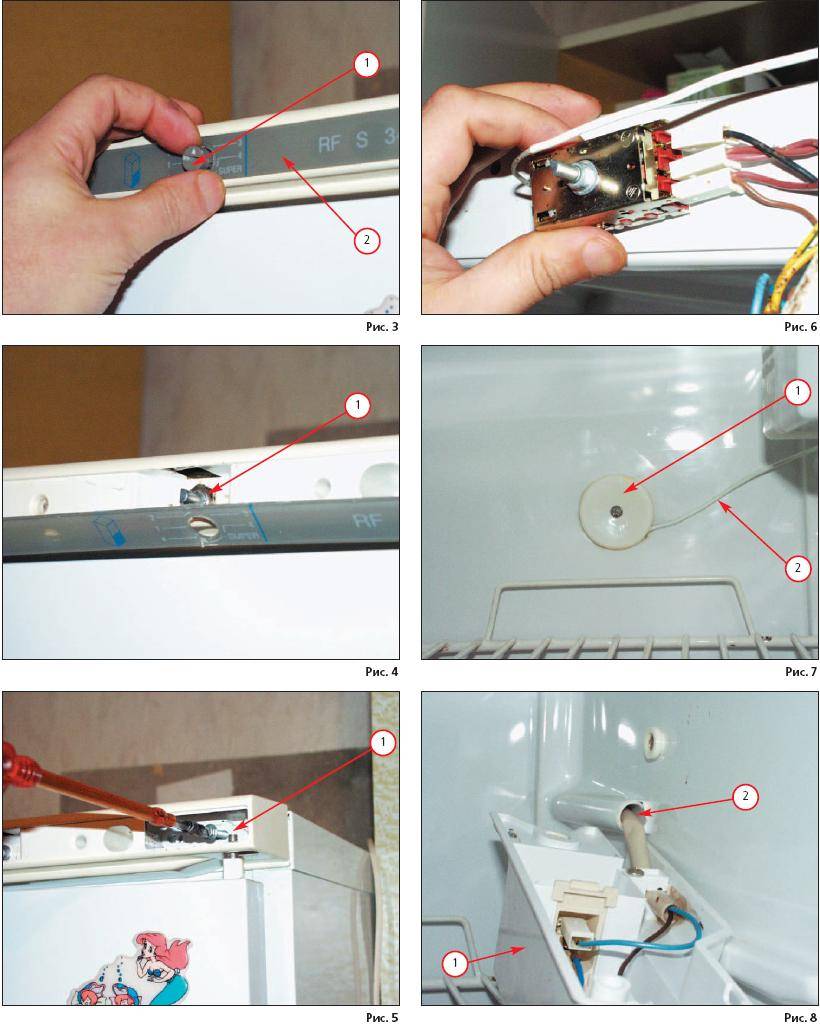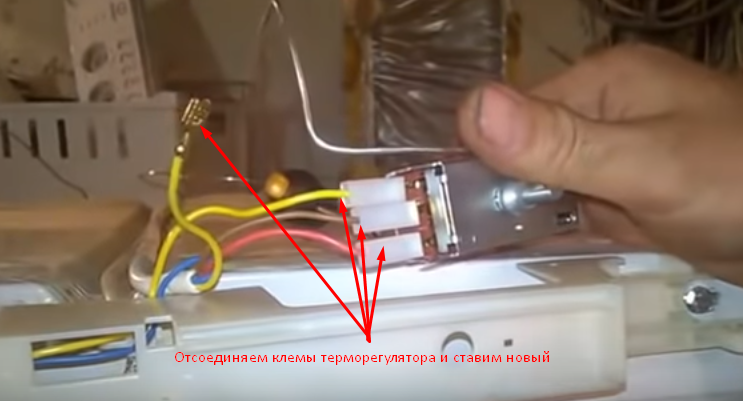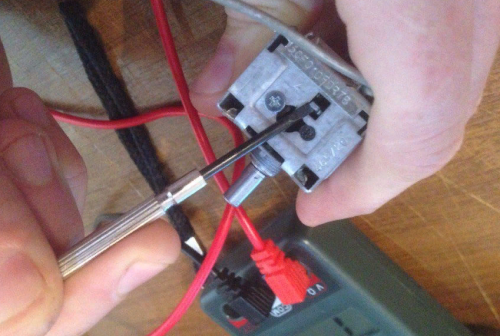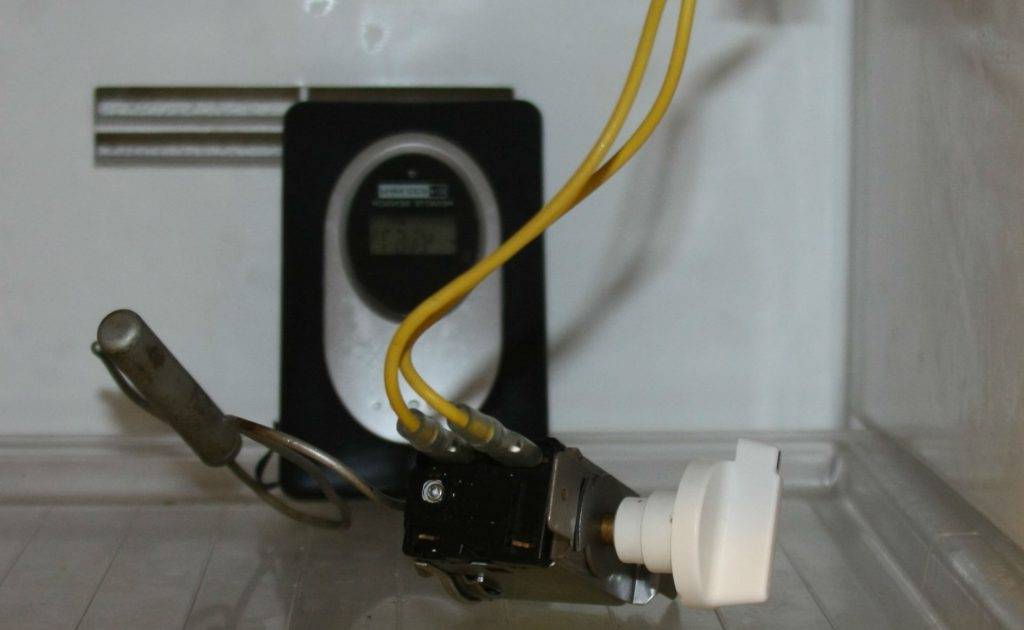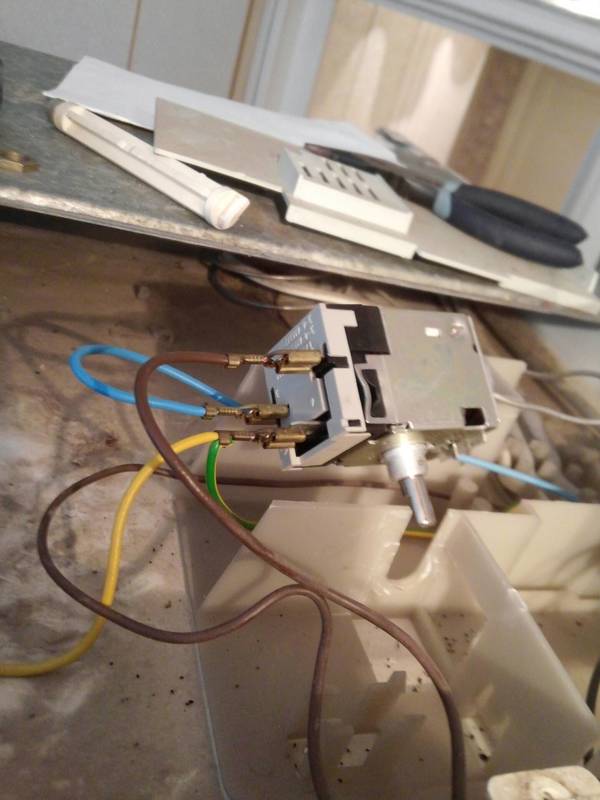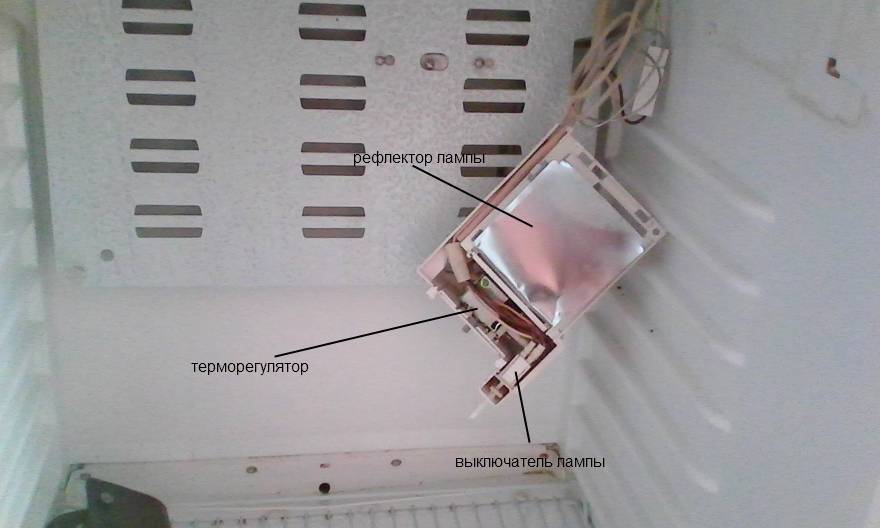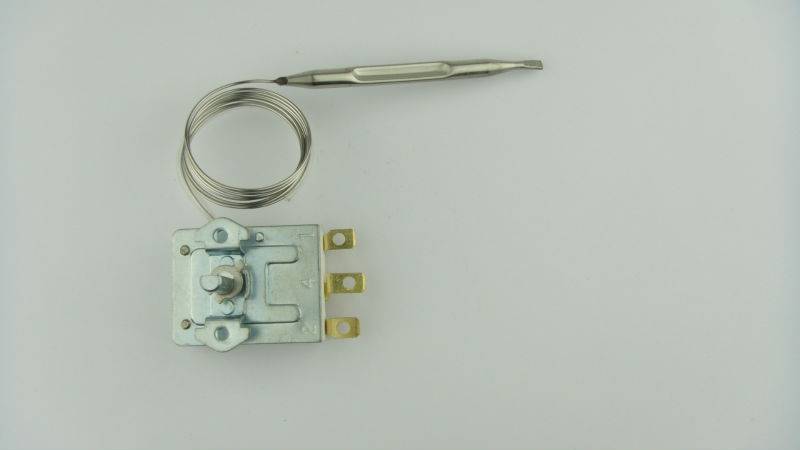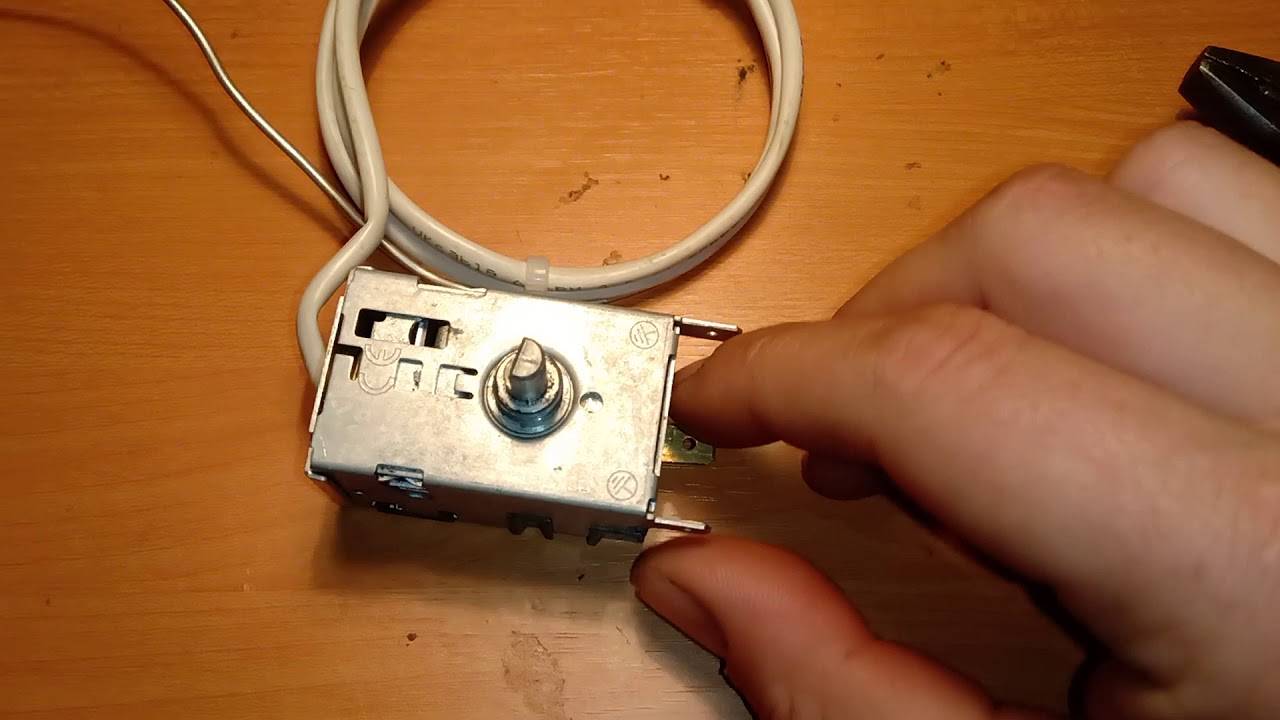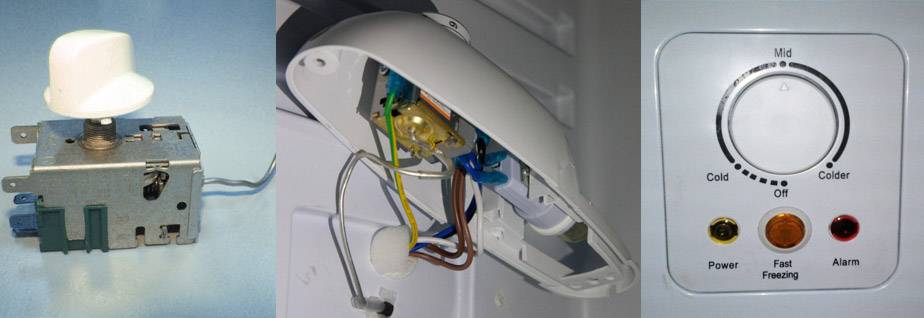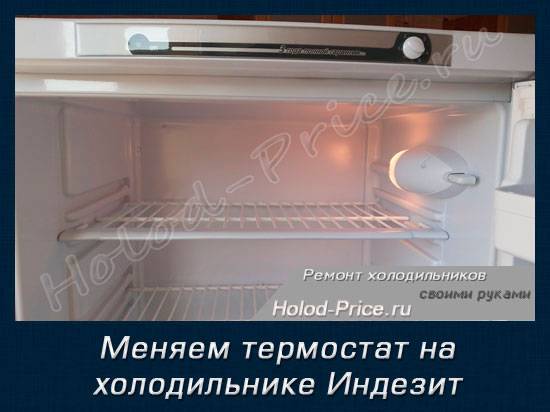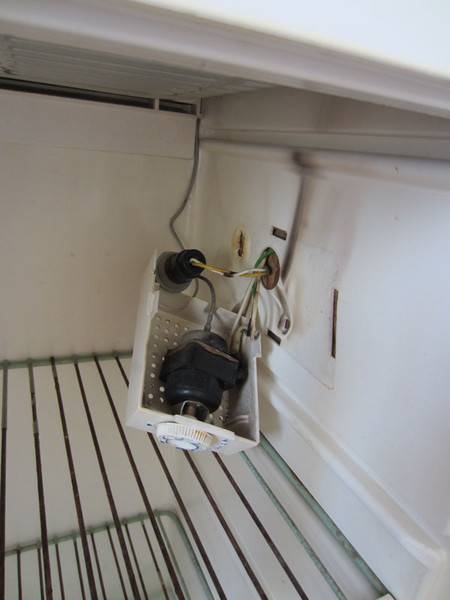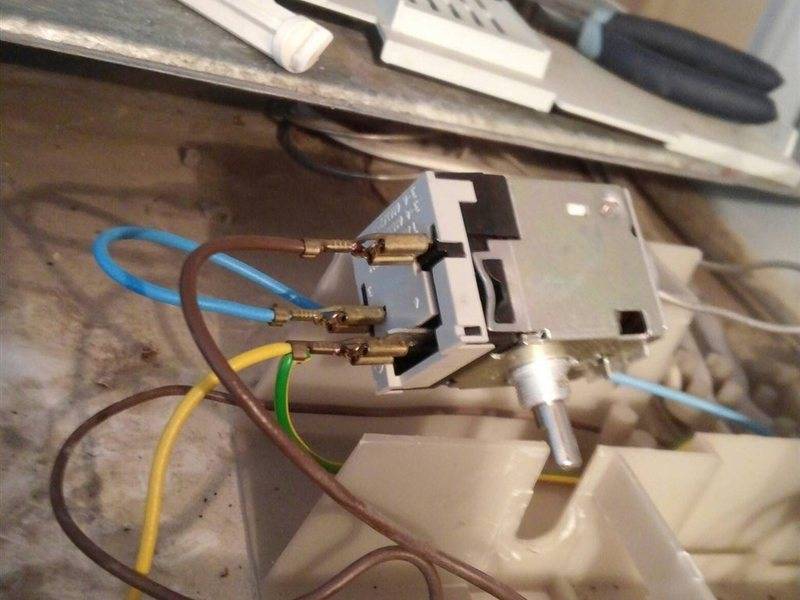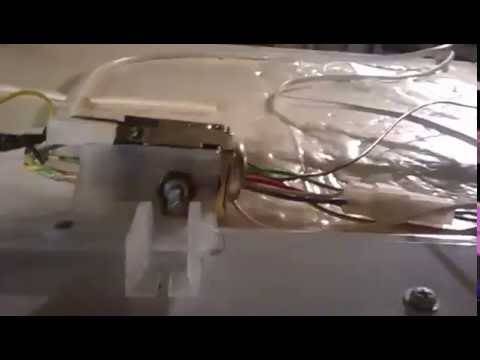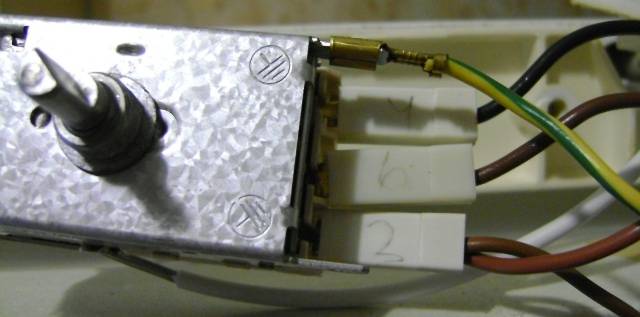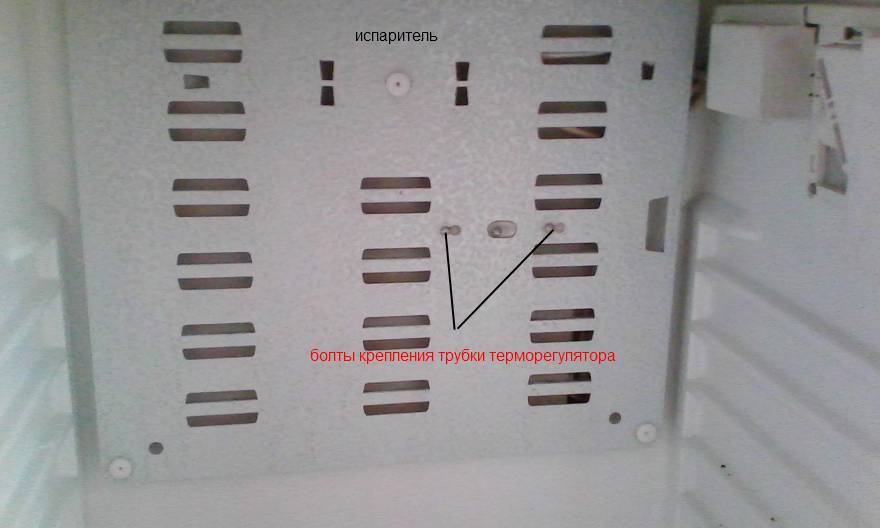Design and purpose
A thermostat, also called a thermostat, is one of the main elements of a refrigerator. It monitors the readings of the temperature sensors and transmits the corresponding signal to the motor-compressor start-up relay. Based on the signals received, the compressor is activated at a low temperature and stops automatically when the temperature reaches the desired level.
The design of the thermostat is a relay, at the tip of which a sealed tube with refrigerant is fixed. On the second base of the relay there are contacts that give a signal about the temperature. The refrigerant in the thermostat reacts even to slight fluctuations in temperature, therefore, its change leads to a change in the pressure level inside the tube, due to which the contacts open or connect.
How to get to the thermostat
It is easy to find, since the thermostat is located in the same place as the knob for setting the temperature. In older models, for example, Oka 6M, it is located inside the refrigerator compartment, on the right wall, next to the lighting lamp. To get to it, they first remove the handle, simply pulling it towards you. Then the protective casing is removed, which is fastened with latches in the holes of the chamber wall.
In modern refrigerator models: such as Indesit, Stinol and others, the thermostat is installed outside, usually above the door, but other options are also possible. You will need a Phillips screwdriver to access it. The path to it also begins with removing the handle, the casing is removed from the latches and retracted, then the self-tapping screws securing the bar with the signal lamp and the thermostat itself are unscrewed.

The thermostat can be located in different places.
Temperature switch replacement procedure
Repairing the refrigerator thermostat on your own will not take a lot of time. Let's take the "Nord" refrigerator as an example:
- Remove the upper hinge cover and unscrew the existing bolts.
- Remove the refrigerator compartment door.
- After that, remove the plug directly in the roof of the refrigerator and unscrew one screw - as a rule, it has a built-in hexagon.
- Unscrew the screws that hold the roof, remove it.
- Remove the temperature control knob.
- Pull out the temperature regulator, before unscrewing the 2 self-tapping screws with which the bracket is attached.
- Replace the unit with a new one and perform all the actions, but in the reverse order.
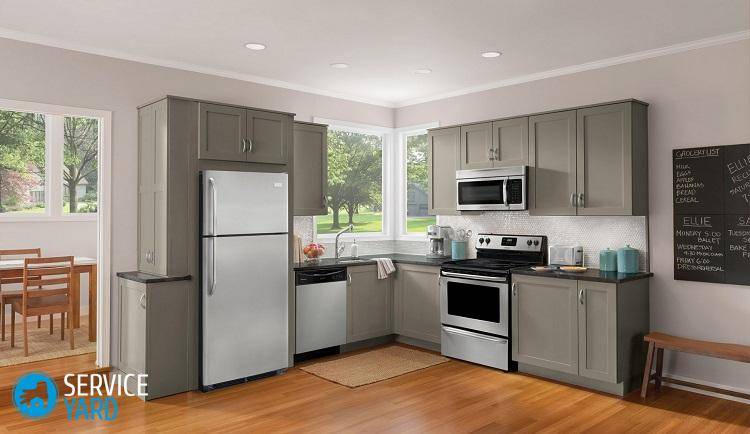
By and large, wherever the thermostat is located, its repair looks approximately the same:
- Get directly to the part itself.
- Disconnect the capillary tube from the body of the evaporator itself.
- Pull it carefully directly out of the housing.
- Disconnect the relay.
- Insert the new bellows tube carefully and then secure it to the evaporator itself.
- Connect all required wires and reattach the relay.
After the repair work on the replacement is completed, it is necessary to check the serviceability of the equipment. Read on our website how to set the temperature in the Samsung Nou Frost refrigerator.
The correct operation of the refrigerator depends on the serviceability of the thermostat. In case of serious breakdowns of the thermostat in the refrigerator, an element must be replaced
To properly install a new component, it is important to first understand the design features.
The main signs of breakage
It is possible to detect a malfunction of the thermostat by different symptoms. Faced with signs of breakdown, it is recommended to immediately start repairs so as not to provoke a deterioration in the condition of the equipment.
Doesn't turn off on its own
Any kind of refrigerator provides for a periodic shutdown when the temperature inside the chamber reaches the required level. If the thermostat breaks down, the relay does not receive a signal about temperature fluctuations, and the refrigerator continues to work continuously. As a rule, with this symptom, a component replacement is required, since repair is impractical.
Turned off and silent
When the refrigerator shuts down and does not resume operation after a certain period, several factors can be the cause of the breakdown. If a light is on inside the chamber and the motor is not running, the likely cause of the malfunction is a burned out compressor. It is often possible to determine a breakdown by the quiet clicks that the start-up relay emits when trying to turn on.
The thermostat itself, which controls the temperature in the refrigerating chamber, does not transmit information through the contacts in the event of a breakdown. The lack of data on the temperature rise leads to the fact that the motor does not turn on.
Snow coat
The formation of ice and snow on the back of the chamber is one of the most popular problems. The malfunction is especially relevant for equipment with a drip defrost function. In the presence of a snow coat in the chamber, the normal mode of food storage is disrupted. Products in the chamber begin to freeze, lose their taste characteristics and presentation. In addition, there is a risk that the snow coat will sometimes melt and the refrigerator will start to leak.

To fix the malfunction, many try to defrost or beat off pieces of ice, but this is not a solution to the problem if the ice has appeared due to a breakdown of the internal part.
If the thermostat malfunctions, the sensor erroneously sends a signal that the temperature is not low enough, and the motor turns on more often to cool the chamber. As a result, the back wall of the chamber does not have time to thaw and is covered with snow. In most situations, replacing the thermostat completely solves the problem.
Where is the thermostat in the refrigerator?
It is not difficult to find it. It is always directly connected to the button or knob of the temperature regulator, it is located in the immediate vicinity of the device for setting the mode. The exact location depends on the model and year of manufacture of the refrigerator.
Possible placement options and ways to gain access to the mechanism:
- The inside of the freezer. The solution is relevant for domestic and some foreign refrigerators, the design of which today can be described by the word "outdated". To see the case of the temperature switch in these models, just open the freezer. One of the panels will have a rectangular plastic box. The desired object is located inside it. To gain access to it, remove the thermostat handle and unscrew the protective box. The latter is sometimes dismantled quite easily; tools may not be needed. You just need to press the latches.
- The outer part. In modern refrigeration units, the relay is located outside the refrigerating chamber, namely in the upper part of the refrigerator, above the wheel. You will need a Phillips screwdriver to access the device. With the help of it, the screws are unscrewed, on which the bar with the signal lamp is attached. But before using the tool, as in the previous case, you will need to pull out the temperature regulator button.
Symptoms of a malfunctioning thermostat
The thermostat is defective if:
The unit works without shutting down
The operability of the thermostat is checked in this case without removing it. For this you need:
- Unplug the plug from the socket.
- Free cameras from food.
- Set the knob to the maximum cold position or start the fast freezing mode, if available.
- Place a thermometer on the middle shelf of the refrigerating chamber (not freezing!), Preferably so that it can measure the subzero temperature.
- Turn on the refrigerator with empty chambers.
- After a couple of hours, remove the thermometer. It should be showing 6 - 7C. If the indications are different, the thermostat will have to be replaced.
So that the check does not take much time, you need to get to the thermal relay and move the plate located near the pin on which the handle is put on. If during its movement there are no clicks or it does not move, the thermostat changes.
If a snow coat appears in the refrigerator compartment, the thermostat does not work correctly or does not work at all.
Refrigeration unit does not start
The cause of this malfunction may be not only a thermal relay, but also a burned-out compressor motor or a breakdown of the start-up relay. But before calling the master, you should check the health of the thermal relay. To do this, you need to remove the casing, having previously disconnected the unit from the power supply, and sort out the wires. In older models, only a pair of wires fit the thermal relay terminals. They are removed and short-circuited with a piece of wire or even a paper clip, bending it appropriately.
The wires were closed among themselves - the compressor started working. It means the thermostat is defective. And if, when the compressor is closed, it does not start, then the start-up relay is faulty or the engine has burned out. Therefore, one cannot do without a master.
In modern units, 4 multi-colored wires are connected to the thermostat:
- the wire from the compressor motor is orange, red or black;
- from the plug - brown;
- from the signal light - white, yellow or green;
- the ground wire is yellow with a green stripe.
You need to close the first 3 wires, and then as indicated above.
Professionals find it more reliable to check with a multimeter, which can also be done by a home craftsman. The thermostat will have to be removed. If the multimeter, the analog switch is set to the position of measuring low resistances, and the arrow with closed probes is set to "0" with the wheel on the left side. On a digital device, the switch is set to "200".
In order for the check to be carried out in conditions as close as possible to the working conditions, the end of the bellows tube is placed in ice water for a couple of minutes. Then measure the resistance between the terminals. If the arrow goes off scale on the analog multimeter, and “1” is displayed on the digital one, the thermostat is sent to the landfill.
Ice build-up on the walls of the refrigerating chamber
This phenomenon is observed with other malfunctions, but the check should begin with the thermostat. To do this, you need to perform the actions specified for the non-shutdown unit. When the thermometer reads 5 - 7 C, the temperature setting knob is turned to the left until the compressor stops. If the compressor stops, the thermostat is good. Otherwise, it is changed. When turned off, the unit is left to work with empty shelves for 5 - 6 hours. At this time, the time between starting and stopping the unit is measured. In normal operation, the intervals are approximately 40 minutes. At lower values - turning the knob to the right adds coldness. If this does not help, change the thermostat.
Why do sensors break down in refrigerators?
There are not so many reasons for the failure of thermal detectors. The main thing is its natural wear and tear - any part develops its reserves over time and needs to be replaced.
The refrigerator temperature sensor is not very expensive. Someone may try to argue with this that they say that this device costs a lot of money for such and such a refrigerator! Let me argue - replacing a thermal detector that costs this "big money" will cost you, in any case, cheaper than buying a new refrigerator. It is much more profitable to recognize the breakdown of the analyzer in time and change it, albeit for 2, 3, 4 thousand, than to let this moment take its course and lay out in the future from ten thousand for replacing the compressor or even more for buying a new refrigerator.
So, before questioning the statement about the inexpensiveness of thermal sensors, check how much you will have to pay if a broken detector will disable other systems.
Another reason may be a voltage drop in the working network. Like any other electrical appliance, the temperature sensor can burn out if the wiring in the apartment is bad or there are network failures, and the outlets in the room are not very good.

There are other reasons, but they are not so frequent and therefore you can not focus on them (mechanical damage, production defects, etc.)
Safety rules to follow when checking
A refrigerator is a large household appliance that requires high voltage to operate. There are three main threats that potentially arise if you decide to renovate your refrigerator:
- electric shock (high voltage appears on the contacts of the relay, thermostat, on the compressor windings);
- electric shock (short circuit inside the electrical wiring of the refrigerating device, due to the ingress of open parts of the wiring on the metal case);
- frostbite due to contact with the skin of the refrigerant.
Anyone who decides to repair the thermostat (or any other component of the refrigerator) must take serious precautions. Do not work while the refrigerator is plugged in: be sure to de-energize the device
As a result (or in the process) of carrying out repair work, wiring contacts are formed, which should be connected to each other. All connections must be properly insulated. It is necessary to continuously check the presence of voltage on all surfaces capable of conducting current - the case, internal elements of the refrigerating chamber, etc.).
All tools (screwdrivers, pliers, multimeter terminals) must have insulated handles.
The device and principle of operation of the thermostat
The thermostat is a relay that turns on and off the refrigerator depending on the temperature in the chambers. A sealed bellows tube filled with refrigerant comes out on one side of it, terminals for connecting wires are located on the opposite side. The end of the tube is attached to the evaporator.

Refrigerator thermostat Indesit.
As the temperature rises, the pressure in the tube increases due to the expansion of the refrigerant, which leads to the closure of the contacts that turn on the compressor. After lowering the temperature, the pressure drops, which leads to the opening of the contacts. The temperature value at which the contacts switch depends on the tension of the spring acting on them. Its effort is regulated by turning the temperature setting knob. The Oka, Atlant and other models with mechanical thermostats are equipped with such a thermostat.

Mechanical thermostat.
Many modern models use electronic temperature control. It consists of a control module and several sensors that monitor the temperature in different zones, sometimes on each shelf. To repair such a system, you will need a deep knowledge of electronics or a call of a master.
How the device works
The direct purpose of the thermostat in the refrigeration unit is to maintain the temperature regime set by the consumer. In compression refrigeration devices, the thermostat turns the compressor motor on and off, and in absorption refrigeration, the heater. The device that regulates the temperature in the cooling chambers is considered a gauge design. This means that the operation of the unit depends on the instability of the pressure of its filler (usually gas) with temperature fluctuations.
A mechanical thermostat is a lever device that has a power lever and a contact circuit.The elastic element (tubular bellows) of the thermoregulatory system and the spring act on the power lever. The electrical part of the device is separated from the mechanical by an electrically insulating gasket.
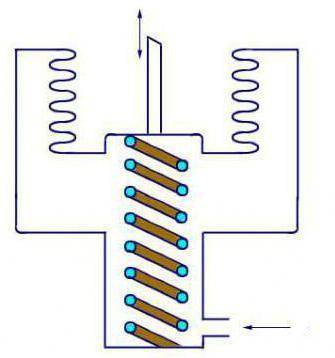
Operating conditions for freon are concentrated steam, the pressure of which depends on temperature conditions. At the end of the tube, liquid gas is already accumulated. The section of the tube, in which the separation of vaporous freon and liquid occurs, reacts to temperature fluctuations. It is this segment that is located in the cooling zone.
How to replace the thermal sensor yourself?
In order to accurately determine whether a thermostat malfunction is the cause of problems, you need to carry out a small diagnosis and only after that start replacing the unit, the process of detecting a breakdown and repairing the refrigerator can be done by hand.
Diagnostics and adjustment
In case of significant freezing of the walls of the freezer, use this method of checking the functionality of the functional unit:

- While the motor is running, slowly turn the regulator knob to increase the temperature inside the compartment.
- After a while, when the level of the set value coincides with the temperature level in the compartment, the sensors will fix the set parameter, and the compressor will receive a shutdown signal. The termination of the motor will mean that the relay is working properly.
- Remove all food from the compartment and leave the refrigerator on for 5-6 hours. During this time, carefully monitor the duration of the breaks in the operation of the motor: if it is at least 30-40 minutes, the household appliance can be used as usual. If not, correct the compressor cycling by changing the thermostat settings.
Determine that the "culprit" of the lack of shutdown of the refrigerator is the thermostat, in this way:
- disconnect the refrigerator from the power supply;
- remove all products and place them in a cool place while checking the functional unit;
- set the knob to the lowest temperature possible or turn on the freezing mode;
- place a thermometer on the middle shelf of the refrigerator compartment that can measure air temperature below 0 ⁰С;
- connect the refrigerator to the power supply;
- after 2 hours evaluate the thermometer readings: if the air in the refrigerator compartment warms up more than 6 ° C above zero, the relay is faulty.
If the household unit does not start working for a long time after being turned off, follow these steps:
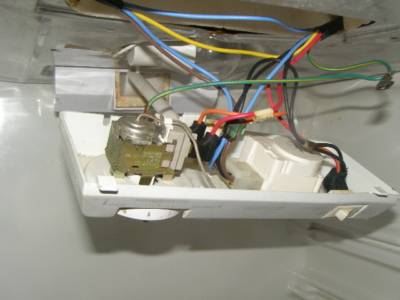
- Switch off the power supply to the refrigerator, remove the thermal relay cover. In older models of refrigerators, two wires fit into the terminals of the functional unit. Disconnect them and connect directly to each other (with a small piece of wire or an unbent paper clip).
If at the moment of closing the contacts the compressor starts to work - the relay is unusable. If the motor does not start, the cause of the malfunction may be a breakdown of the start-up relay or the motor.
In more modern models of household refrigerators, 4 wires are suitable for the thermostat:
yellow with a green stripe - ground;
orange (or red, black) connects the unit to the compressor;
brown - "zero", leads to the fork;
white (or yellow, green) is connected to a light bulb in the refrigerator compartment.
To troubleshoot the thermostat, short-circuit all wires except ground. If the motor turns on, the regulator is faulty.
Instruments
To repair the refrigerator yourself (replace the regulator), you will need:
- flat and cross-head screwdriver;
- knife;
- round nose pliers;
- spare part of a suitable modification.
Rules for dismantling the thermal relay
In older models of the refrigerator, the thermostat is located inside the household appliance. To remove the element, it is necessary to dismantle the temperature control knob and the protective plastic case.In more modern refrigerators, the thermostat is usually located outside the chamber and can be located at the top, directly above the door.
Dismantling the defective part:
- Remove the protective cover of the element.
- Disconnect the capillary tube from the evaporator, carefully pull it out of the housing.
- Unscrew the retaining bolts and remove the relay. The block with contacts and a regulator can be fastened either with screws or with latches.
- Disconnect all terminals with wires that are connected to the thermostat. To avoid confusion with the connection when installing a new part, write down the color coding of all wires.
- Remove the defective item from the refrigerator.
De-energize the household appliance before replacing a functional unit.
Replacement
- Carefully so as not to damage the part, insert the new bellows tube into the body and attach it to the evaporator. The part must be pressed against the wall of the element.
- Connect the relay wires.
- Reinstall a working thermostat.
- Attach the protective cover, all panels and assemblies that were removed when the assembly was removed.
- Connect the refrigerator to the power supply.
Checking the refrigerator thermostat: method number 3
And finally, the third way is to check it with a tester. This already requires a thermostat demonade. We transfer the tester to the resistance measurement mode and set it to the minimum: analog to "X10", digital to "200". You can also set the tester to ring the circuit. The analog tester must be calibrated before use: close the probes and set the arrow to zero with the side wheel.
To create conditions close to the operating conditions of the refrigerator thermostat, the removed part should be immersed in a glass of cold water for 1-2 minutes. Then we "ring" the thermostat. The number "1" on the tester screen clearly indicates a breakdown of the thermostat. Should be "0". Such a thermostat cannot be restored and requires an unambiguous replacement.
If you managed to dismantle the part yourself and you even remembered the sequence in which you removed the wires and terminals, then you can easily connect the new thermostat yourself. If you stopped at one of the first two methods of checking, it is better to refer to the wizards from ALM-remont. Also, do not postpone the call if the thermostat turns out to be working properly. This means that the breakdown is much more serious and fraught with complications up to a complete stop and.

Repair of refrigerators, including the repair of Liebherr refrigerators with a faulty thermostat, is part of the professional activity of our company.
Our next article will be devoted to refrigerator thermostats - a description of their functions and the possible consequences of their breakdown. We will also tell you about the replacement of thermostats and their repair.
Thermostat
- this is one of the important parts of any refrigerator. Purpose of the thermostat
- maintaining a constant set temperature in a cooling device, in our case, in a household refrigerator. A thermostat and a thermostat are not the same thing, as many people mistakenly think.
The thermostat has an automatic principle of operation, it turns off or turns on the cooling device itself, automatically - when certain conditions are reached. And the thermostat is manually controlled.
Schematically, any thermostat consists of a container with freon and a bellows (capillary) tube. This tube acts as a thermally sensitive element. The bellows tube is attached to the evaporator.
As soon as the temperature in the evaporator rises or falls, the pressure in the tube, respectively, also falls or rises, and as a result of this, the contact elements in the power supply circuit of the motor-compressor open and close.
Depending on the manufacturer, model features and production time of your refrigerator, one of several types of thermostats can be installed on it.But in fact they are completely identical - their main difference is only in the temperature limit at which the compressor starts or stops.
A malfunction or breakdown of the thermostat is the cause of a wide variety of malfunctions in the refrigerator. And, unfortunately, replacing the thermostat is one of the most common services of any service company.
The main reason for the failure of thermostats is either natural wear and tear or sudden temperature changes.
Operating rules
To reduce the likelihood of malfunctions associated with the incorrect functioning of the thermostat, it is possible to comply with the rules for operating the equipment. The basic rules are as follows:
- Hot food must not be left in the chamber. Otherwise, the compressor will operate without stopping for a long time, and this will affect the performance of the temperature sensor.
- The refrigerator should not stand close to the wall. Tight placement leads to a decrease in power, overheating of the motor-compressor, accelerated wear of parts.
- If the equipment requires periodic defrosting, this requirement should not be neglected.

Thermostat is a functional unit of the refrigerator, consisting of a metal bellows, a long tube with refrigerant in contact with the evaporator, springs, regulator knobs, contacts. There are electronic devices that represent a control module with temperature sensors located inside the chambers.
The thermostat is designed to maintain the specified temperature parameters in the refrigerator chambers by automatically controlling the operating mode of the compressor electric motor.
Repair Specialist Tips

Before replacing the relay (removing panels, casing and housing, disconnecting wires and other operations), memorize, write down the sequence of actions or photograph each stage of dismantling - this will come in handy when assembling a household appliance.
Exercise extreme caution and accuracy in handling the bellows tube: this part is easy to damage, and an incorrect position of the element, the admission of kinks, leads to incorrect operation of the refrigerator.
It is unacceptable to solder the relay wires to the terminals - this can lead to failure of the element, insulation breakdown, short circuit to the metal case of the household appliance.
The operating mode of the refrigerator compressor depends on the correct operation of the thermostat. A malfunction of the temperature relay leads to an early failure of the equipment, therefore, at the first signs of a breakdown of a functional unit, it must be repaired or replaced.
DIY replacement
To install a new thermostat, you do not need to have special skills. In doing so, you should adhere to a few tips that will help you avoid difficulties. In particular:
- All operations should be photographed sequentially in order to carry out installation after dismantling in the reverse order. You need to know exactly where the conductors of the cables were located, as rearrangement will cause incorrect operation.
- If the thermostat is outside, it may be necessary to completely remove the chamber door. To do this, you will need to unscrew the hinges, having previously removed the cover over the upper hinge, under which the bolts are hidden.
- It is better to put all clamps and pads in a separate container so as not to lose.
The very procedure for installing a new thermostat requires the reverse order of assembly. The component is put in place and securely fixed with fasteners.
Examination
Before replacing the thermostat, it is recommended to check its operation. The test procedure depends on the detected symptoms of a malfunction. If the refrigerator runs continuously and the motor does not stop, you need to do the following:
- disconnect the refrigerator from the power supply and remove all food from the chamber;
- switch the temperature regulator knob to the coldest mode or turn on the fast freezing function (if available);
- leave a thermometer on the central shelf of the chamber, which is capable of measuring negative temperatures;
- start the refrigerator and leave for 2-3 hours;
- remove the thermometer and check the temperature - it should display 6-7 degrees, and if there is a strong deviation, the thermostat needs to be replaced.
To simplify checking and not waste a lot of time, you can get to the thermostat and move the plate to the sides, which is located near the pin holding the handle. If, when the plate moves, no clicks are heard or it remains stationary, the thermostat is replaced.

When the refrigerator does not turn on, the problem may be related to the operation of the compressor or the start-up relay.
Having removed the thermostat, you need to inspect it from all sides, paying special attention to the wires that supply power. The wires have different markings, which indicate their purpose.
To check the performance of the thermostat, you need to take all the wires, except for the yellow one with a green stripe, disconnect and short-circuit each other. Then the refrigerator is turned on, and if the appliance does not start, there is probably a problem with the compressor. If, after shorting the wire, the motor begins to function, then the relay needs to be replaced so that the problem does not arise in the future.
Temperature regulator device
The thermostat is a fairly simple device. Even in modern cold rooms and refrigerators, this is a simple contact group. It is controlled by a manometric device with a capillary tube, the end of which is in the chamber and measures the temperature. Today there are two types of temperature controllers in refrigerators: mechanical and electronic.
A modern thermostat has two main elements. This is a box in which the control and executive mechanisms are located, and a capillary extended into a tube. The box is a bellows (hermetically sealed tubular spring). The accuracy of the determined indicators depends on its tightness. The compression and expansion of the bellows is controlled by a spring, optimizing it for pressure. Modern mechanical thermostats can have multiple springs. It depends on the destination: refrigerator or freezer.
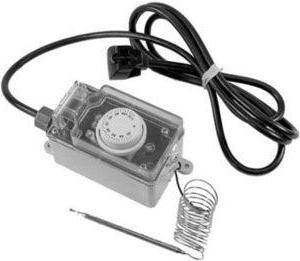
More reliable and allowing to smoothly regulate the operation of the entire refrigeration system - an electronic thermostat for the refrigerator. The price of this device is much higher than mechanical ones and ranges around two thousand rubles (while a mechanical one costs up to a thousand). In an electronic thermostat, a thyristor, sometimes a resistor, is responsible for the sensitivity.
In refrigerators with high energy consumption, these thermostats quickly fail. In A + refrigeration units with linear compressors, electronic temperature controllers need to be replaced much less frequently. Therefore, most of the manufacturers of such equipment today are switching to linear compressors with electronic thermostats.
Signs of a broken temperature relay
There are a number of signs indicating a thermostat failure:
- violation of the cyclicity in the operation of a household appliance (the unit operates for a long time without independent shutdown);
- the rapid growth of a layer of frost in the freezer, the appearance of ice in the refrigerator compartment;
- the electrical device does not turn on for a long time.
Such problems may indicate malfunctions in the operation of the relay or be the result of other malfunctions of the refrigerator (refrigerant leaks, engine breakdowns, door tightness, etc.).
Snow coat in the freezer
 If a significant layer of frost is found on the walls of the freezer, first make sure that the temperature mode is correctly selected, check the tightness of the narthex of the chamber door.If everything is in order, there is a high probability of a thermostat malfunction.
If a significant layer of frost is found on the walls of the freezer, first make sure that the temperature mode is correctly selected, check the tightness of the narthex of the chamber door.If everything is in order, there is a high probability of a thermostat malfunction.
After setting the set temperature in the freezer, the failed sensor does not send a signal to the start relay of the refrigerator compressor to complete the cooling cycle. The motor continues to run, the evaporator does not have time to thaw, and a snow crust rapidly builds up inside the chamber.
If the refrigerator is equipped with two thermostats and independent temperature control in the compartments, ice can form in the freezer and refrigerator compartment.
Disconnected and silent
Reasons for shutting down the refrigerator:
- external factors (for example, power outage due to power surges, faulty outlet, plug or cable);
- breakdown of the relay for starting the motor, electric motor;
- failure of the thermostat.
A broken relay does not respond to an increase in the temperature level in the refrigerator compartment, a signal is not sent to the start relay, and the motor does not turn on.
A symptom of a malfunctioning thermostat is the complete absence of noises, sounds, clicks in the refrigerator, which indicate attempts to turn on the motor.
Doesn't turn off on its own
The reason for the lack of shutdown of the unit, in addition to violation of the rules for the operation of household appliances, loose door fit, breakdown of the start-up relay, refrigerant leakage, may be a thermostat malfunction, which stops signaling the need to stop the compressor. The motor continues to run without stopping, which leads to overheating and failure.
Malfunction of the thermostat in the Stinol refrigerator
This brand of refrigerators is very popular in our country. Almost the only drawback of such units is that the thermostat becomes faulty very quickly (after 5-6 years of operation). The reason for the breakdown is the short working life of this device supplied by the German company RANCO (5 years). The tightness of the bellows, which is sensitive to temperature fluctuations, is broken in the thermostat.
Defects indicating that it is the refrigerator thermostat that is faulty:
- "Stinol" does not start when the switch is turned to the "off" mark (no click).
- The temperature regime in the refrigerator is higher than the norm, even when the regulator is in “maximum” position.
- The compressor of the device works without interruption, even when the control knob is in the “off” position.
At home, it is impossible to accurately determine the malfunction of the thermostat of the Stinol refrigerator. But if, with the contacts closed by the jumper, the compressor turns on, it means that there is a high probability that the temperature regulator is faulty, and therefore it is necessary to contact a company that makes urgent repairs to refrigerators.



